Explore Paju - South Korea Travel, Asia
Paju is a city located in Gyeonggi Province, South Korea, situated just northwest of Seoul and just south of the Korean Demilitarized Zone (DMZ) near Panmunjeom, along the 38th parallel. Covering an area of approximately 672.78 km² (259.76 sq mi), Paju stands as a poignant reminder of the Korean Peninsula's complex history. This city has witnessed the ebb and flow of conflict and peace, emerging as a unique destination that blends historical significance with contemporary cultural richness.
Population: Approximately 440,000 in 2024.
Economy: Paju's economy is diverse, with a strong emphasis on the publishing industry. It is famously known as the center of book publishing in South Korea, housing Paju Book City, which includes around 900 businesses related to the book industry, such as printing firms, distribution companies, and design studios. This hub was established to consolidate the fragmented book sector and has been pivotal in modernizing South Korea's publishing landscape.
Landmarks: Paju Book City, Heyri Art Village, Odusan Unification Observatory, Dorasan Station, Imjingak Park.
South Korea
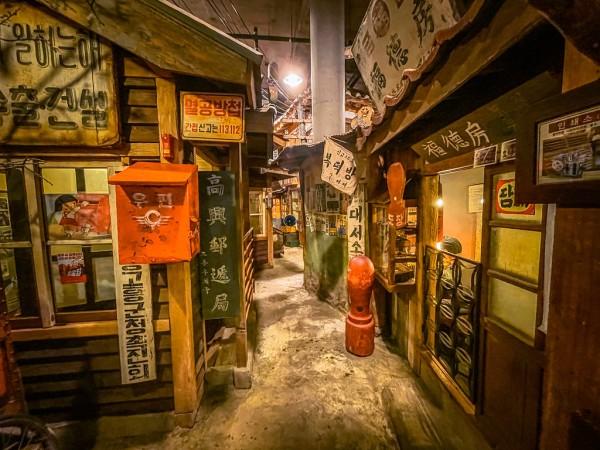
Overview of Paju
History & Culture Influence
Paju's history dates back to ancient times, with archaeological evidence indicating human settlement in the area for thousands of years. Its strategic location near the Korean Demilitarized Zone (DMZ) has made it a focal point in Korea's long history, particularly during the Korean War. In 1997, Paju was designated a city, transitioning from its previous status as a county. This change marked a significant step in its development, allowing for urban expansion and modernization.
Paju is renowned as a cultural hub, particularly in the realm of publishing. The establishment of Paju Book City in 1998 transformed the city into a center for the book industry, housing around 900 businesses related to publishing, printing, and design. This initiative aimed to consolidate the fragmented book sector in South Korea and has contributed to Paju's identity as a "City of Books." The area's focus on literature and education has fostered a vibrant cultural scene, attracting writers, artists, and scholars.
Interaction with The Locals
Locals in Paju are generally friendly and hospitable, often eager to share their culture and history with visitors. The city's historical significance, particularly its proximity to the Korean Demilitarized Zone, makes it a point of interest for many tourists. Residents are accustomed to interacting with tourists, especially in popular areas like Paju Book City and Heyri Art Village, where cultural exchanges are common. Visitors may find that many locals are willing to help with directions or provide recommendations for local attractions and dining options.
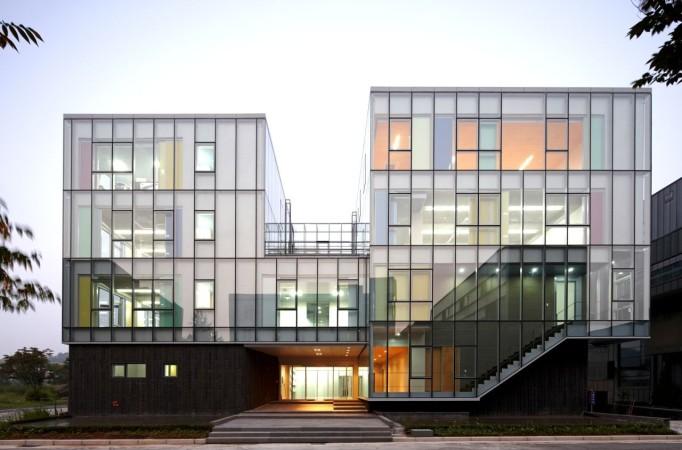
Paju Book City - © Arch Daily
Top Attractions in Paju
- DMZ (Demilitarized Zone): The DMZ is undoubtedly one of the most historically significant places in Paju. This heavily fortified border zone separates North and South Korea, and visiting it offers a unique glimpse into the history and ongoing tensions of the Korean Peninsula. Guided tours take you through key sites, providing an in-depth look at the events that shaped the region, along with insights into the current status of both countries.
- The Third Tunnel of Agression: Discovered in 1978, the Third Tunnel is a fascinating relic from a tense period in Korean history. This tunnel, dug by North Korea as a potential invasion route, now serves as a tourist site. Visitors can walk through parts of the tunnel and learn about its strategic importance and the ongoing conflict between North and South Korea. It’s an eerie yet intriguing experience that offers a rare peek into the realities of the Cold War era.
- Panmunjom: Panmunjom, also known as the Joint Security Area (JSA), is where North and South Korean forces come face to face. This area has played a key role in peace talks and negotiations between the two countries. Visiting Panmunjom gives tourists a firsthand look at the intense military presence and ongoing diplomatic efforts. It’s an eye-opening experience that highlights the complexities of the Korean conflict.
- Paju Book City: Paju Book City is a dream destination for book lovers. This cultural hub is dedicated to the publishing industry and is filled with bookstores, cozy cafes, and galleries. Throughout the year, it hosts a variety of literary events and exhibitions. Whether you're looking to immerse yourself in Korean literature or just enjoy a quiet day exploring unique publications, Paju Book City offers a peaceful, intellectual retreat.
- Heyri Art Village: Heyri Art Village is a vibrant community that celebrates creativity in all its forms. Here, you’ll find art galleries, studios, and cafes, making it an inspiring space for both artists and visitors. It’s a fantastic place to experience contemporary Korean art, and you can even take part in workshops to unleash your own creative side. The village fosters a spirit of cultural exchange and is a must-visit for art enthusiasts.
- Paju Jangneung Royal Tombs: The Paju Jangneung Royal Tombs are part of the Joseon Dynasty’s legacy and have been recognized as a UNESCO World Heritage site. These beautifully preserved tombs offer a glimpse into Korea’s royal past and burial traditions. Exploring the site is a peaceful experience, and the serene surroundings make it easy to imagine the grandeur of the past.
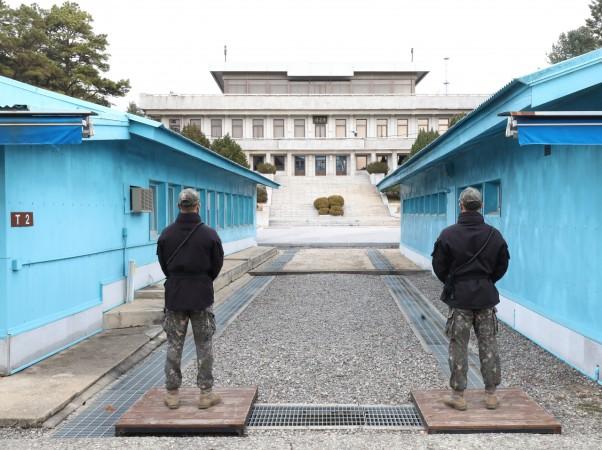
Panmunjom - © heraldm
Must-Try Dishes in Paju
When visiting Paju, don’t miss out on Paju Hanjeongsik, a traditional Korean meal that offers a variety of small dishes like rice, soup, and local side dishes, giving you a true taste of the region. Another must-try is the Pyeongyang Handmade Dumplings, delicately filled with seasoned pork and vegetables, showcasing the shared culinary heritage of the Korean Peninsula. For something heartwarming, try Paju Chicken Noodles, a comforting dish featuring tender chicken and vegetables in a savory broth.
- Paju Hanjeongsik: Paju Hanjeongsik is a must-try if you want to experience the true essence of Korean cuisine. This traditional breakfast features a delightful spread of small dishes, including rice, soup, kimchi, and an assortment of banchan (side dishes) made from fresh, locally sourced ingredients. It’s a fantastic way to dive into the region’s flavors and get a taste of Korean culinary tradition all in one meal.
- Pyeongyang Handmade Dumplings: Pyeongyang Handmade Dumplings are a local favorite in Paju, offering a delicious bite of history and tradition. These delicate dumplings, stuffed with seasoned pork and vegetables, are carefully crafted by hand using a recipe that’s been passed down for generations. With Paju’s close proximity to North Korea, these dumplings beautifully represent the shared culinary heritage of the Korean Peninsula.
- Paju Chicken Noodles: Looking for something comforting and hearty? Paju Chicken Noodles is the dish for you. This popular local specialty features tender chicken, noodles, and vegetables swimming in a rich, savory broth. Simple yet incredibly satisfying, it’s a great example of how the region uses fresh ingredients to create meals that are both nourishing and flavorful.
- Bangujeong Naruteo Jib: Bangujeong Naruteo Jib is a local gem for Korean barbecue lovers. At this restaurant, you can enjoy a variety of marinated meats, from pork to beef, grilled right at your table. Paired with an array of banchan and a bottle of soju, it’s more than just a meal—it’s a full-on dining experience that captures the essence of Korean food culture.
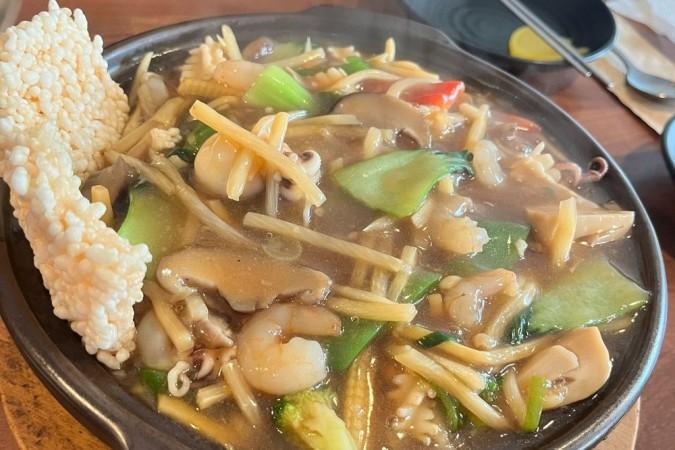
Samseon Haemul Nurungji Tang - © Cherry Chu Magazine
Weather in Paju: Best Time to Visit
Paju experiences a temperate climate with distinct seasons, making it essential for travelers to understand the weather patterns when planning their visit.
Average Temperatures
- Summer (June to August): Temperatures range from 20°C to 30°C (68°F to 86°F). Summers are typically warm, muggy, and can be quite wet due to monsoon rains.
- Autumn (September to November): Average temperatures fall between 10°C and 26°C (50°F to 79°F). This season is characterized by mild weather and colorful foliage.
- Winter (December to February): Temperatures can drop to -10°C to 5°C (14°F to 41°F), with cold and snowy conditions. Winters are mostly clear but can be quite freezing.
- Spring (March to May): Temperatures gradually rise from around 5°C to 20°C (41°F to 68°F). Spring is known for its pleasant weather and blooming flowers.
Paju receives significant rainfall, particularly during the summer months, with July being the wettest month. The average annual rainfall is around 1,200 mm (47 inches), with a considerable portion falling between June and August.
Best Time to Visit
The best times to visit Paju are during spring (April to June) and autumn (September to October). These seasons offer mild temperatures, less humidity, and beautiful natural scenery, making it ideal for outdoor activities and sightseeing.
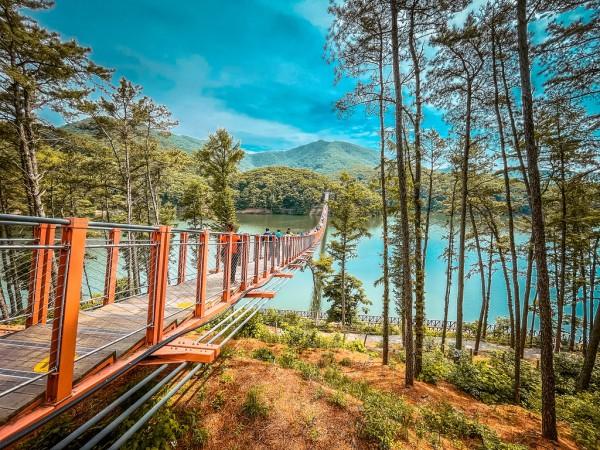
Majang Reservoir - © Adventures With NieNie
Festivals & Local Celebrations
Paju hosts several exciting events and festivals throughout the year, showcasing its cultural heritage and community spirit. Here are some notable events you might consider during your visit:
- Paju Booksori Festival: This annual festival celebrates literature and the arts, held in Paju Book City. It features book fairs, author talks, and various cultural performances, attracting book lovers and families alike.
- Paju Gaesung Ginseng Festival: Celebrated in the fall, this festival highlights the region's famous ginseng. Visitors can enjoy tastings, purchase ginseng products, and learn about its health benefits through workshops and demonstrations.
- Paju Trout Festival: Typically held in winter, this festival allows visitors to experience trout fishing and enjoy various trout dishes. It’s a fun family-friendly event that promotes local fishing culture.
- Byukchoji Garden Chrysanthemum Festival: This festival takes place in the autumn at Byukchoji Garden, showcasing beautiful chrysanthemum displays. Visitors can enjoy flower exhibitions, cultural performances, and various food stalls.
- Byukchoji Gardens Tulip Festival: Held in spring, this festival celebrates the blooming of tulips in Byukchoji Gardens. It features vibrant flower displays, art installations, and family-friendly activities.
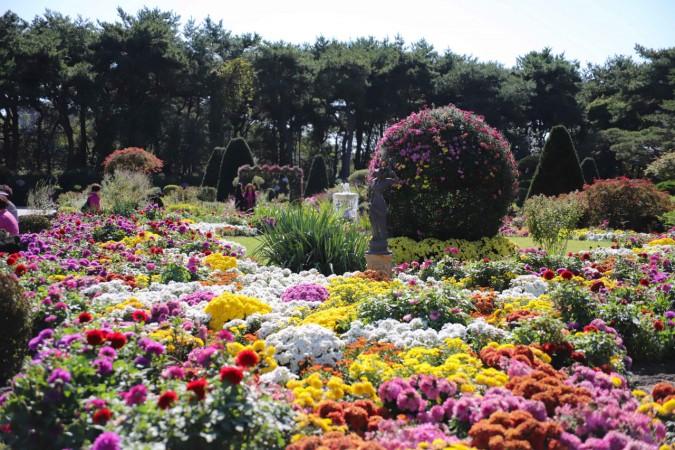
Trout Festival - © Brunch Story Korea
What to Do in Paju
Paju, a city known for its historical significance and natural beauty, offers a variety of activities for all kinds of travelers. Located near the Demilitarized Zone (DMZ), it’s a must-visit for those interested in Korean history and culture.
- Visit the DMZ: One of Paju’s most famous attractions is the Demilitarized Zone (DMZ). Visitors can tour historical sites like Imjingak Park and the Third Tunnel of Aggression, which provide insights into the Korean War and ongoing peace efforts.
- Explore Heyri Art Village: For art lovers, Heyri Art Village is a vibrant community is home to artists, writers, and musicians, featuring galleries, studios, and cafes. It’s the perfect place to spend a relaxed day exploring art exhibitions and unique architecture.
- Walk Through Provence Village: Inspired by the French countryside, Provence Village is another must-see. This colorful village is filled with European-style cafes, shops, and gardens. It’s a great spot for photos, enjoying French-inspired cuisine, or simply taking a leisurely stroll.
- Visit Paju Book City: Paju Book City is a UNESCO-recognized publishing center dedicated to books and literature. Visitors can browse through numerous bookstores, attend literary events, and explore the art of publishing. It’s a paradise for book lovers looking for rare finds or cultural insights.
- Outdoor Activities: Paju’s scenic surroundings make it ideal for nature lovers. You can hike Gamaksan Mountain for panoramic views of the city and the DMZ, or visit Pyeonghwa Nuri Park for peaceful walks amidst beautiful landscapes. The park is also a popular spot for picnics and kite flying.
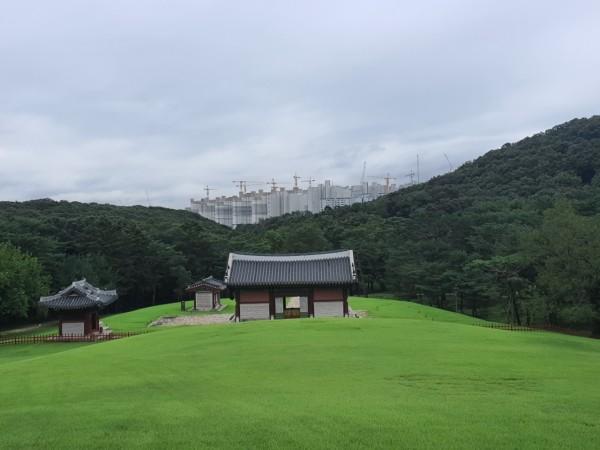
Jangneung Royal Tombs - © Incheonin
Essential Travel Information
Getting Around Paju
- Public Transit: Paju has an extensive public transportation system, including buses and a subway line. The Paju City Bus network connects various neighborhoods and attractions, making it easy to navigate the city .
- Subway: The Gyeongui Line connects Paju to Seoul and other nearby areas, providing a convenient option for those traveling to and from the city.
- Taxis: Taxis are readily available throughout Paju and are a convenient way to travel, especially for short distances or when public transport may not be as accessible.
- Ride-Sharing Services: Ride-sharing services like Kakao T are available in Paju, allowing visitors to book rides easily through their smartphones.
ATM and Banking Services
Paju has several ATM locations provided by major banks like Shinhan Bank:
- Shinhan Bank ATM at Tanhyeon-dong Samik Apartment in Goyang-si
- There are also ATMs installed by Hyosung, a major ATM manufacturer, at various locations in Paju:
- Hyosung ATM at 7-Eleven convenience store in Geumchon-dong
- Hyosung ATM at Universal Logistics in Geumchon-dong
- Hyosung ATM at Fami Mart in Adon-dong
Additionally, the U.S. Department of Defense has a Community Bank with an ATM located at Camp Casey in Paju.
Where to Stay in Paju
- Boutique Stays: For those looking for a unique and stylish experience, Paju has several boutique accommodations that reflect the city’s artistic and cultural vibe. These establishments provide customized service, handy amenities, and attractive decor.
- Family-Friendly Stays: Paju is also home to many family-friendly lodgings that offer spacious rooms and family-oriented facilities. Many of these places often provide amenities such as play areas, family suites, and easy access to local parks and entertainment options.
- Luxury Stays: For travelers seeking a more luxurious experience, Paju has high-end accommodations that offer premium amenities, including wellness facilities, fine dining, and spacious rooms with stunning views. These luxury stays are often located near peaceful natural surroundings or cultural sites, making them a perfect choice for those wanting a refined and comfortable retreat after a day of exploring.
Articles for you

Explore Yala National Park - Sri Lanka Travel, Asia
Tucked away in Sri Lanka’s southeastern corner, Yala National Park is where wild nature meets deep tradition. Known worldwide for its leopard population, the park is also home to elephants, sloth bears, crocodiles, and hundreds of bird species. Beyond wildlife, Yala opens doors to a cultural landscape dotted with ancient temples, Buddhist ruins, and coastal villages. For travelers seeking more than just a safari, Yala offers a chance to explore eco-tourism, local communities, and sacred heritage sites.
Population: The Yala National Park area doesn’t have a human population.
Economy: The economy around Yala National Park thrives on a blend of eco-tourism, agriculture, and local services. Safari tours, eco-lodges, and cultural experiences drive steady income for nearby towns like Tissamaharama and Kataragama, supporting thousands of families.
Landmarks: Famous for Block I of Yala and wildlife encounters, including elephants, sloth bears, crocodiles, and exotic bird species.

Explore Galle - Sri Lanka Travel, Asia
Nestled on Sri Lanka’s southern coastline, Galle is a vibrant city where history meets the sea. Its cobbled streets, colonial architecture, and serene beaches make it a must-visit destination for travelers seeking a blend of culture, adventure, and relaxation. A UNESCO World Heritage site, Galle captivates visitors with its Dutch Fort, bustling markets, and friendly locals. Whether you’re exploring the ramparts at sunset or savoring fresh seafood by the shore, Galle promises an unforgettable journey into Sri Lanka’s heritage.
Population: Approximately 113,000 in 2023.
Economy: Galle’s economy thrives on tourism, trade, and fisheries. The city’s historic fort, colonial architecture, and coastal charm draw thousands of international visitors each year, making tourism its main economic driver. Fishing remains vital for local livelihoods, supplying fresh seafood across the region.
Landmarks: Famous for the Galle Fort, Dutch Reformed Church & Maritime Museum, and Unawatuna Beach.

Explore Bentota - Sri Lanka Travel, Asia
Nestled along Sri Lanka’s southwestern coast, Bentota is a tropical paradise that blends golden beaches, vibrant culture, and thrilling adventures. Famous for its calm waters, luxury resorts, and scenic river estuary, Bentota has become a top destination for travelers seeking both relaxation and authentic experiences. From serene beach walks at sunrise to adrenaline-pumping water sports, this coastal town offers a perfect balance of leisure and exploration. With its proximity to Colombo and Galle, Bentota is easy to reach, making it an ideal stop for both short escapes and extended holidays.
Population: Approximately 37,000 in 2023.
Economy: Bentota’s economy thrives mainly on tourism, which drives local businesses such as hotels, restaurants, and wellness retreats. The town also benefits from fishing, coconut cultivation, and handicrafts like wood carving and batik textiles. Many residents rely on the growing demand for water sports and Ayurvedic treatments, making tourism the backbone of both income and employment in the area.
Landmarks: Famous for Bentota Beach, Bentota River Safari, and Kande Vihara Temple.

Explore Mirissa - Sri Lanka Travel, Asia
Mirissa is a charming coastal town on Sri Lanka’s southern shoreline. Known for its golden beaches, turquoise waters, and vibrant marine life, it has become a must-visit stop for travelers exploring the island. Many come for whale watching, surfing, and sunset views at Coconut Tree Hill, but Mirissa offers much more than postcard beauty. The fishing boats you see anchored by the bay carry generations of stories. Local traditions, delicious cuisine, and a laid-back rhythm of life shape every visitor’s experience.
Population: Approximately 4,700 in 2023.
Economy: Mirissa’s economy is largely shaped by its coastal location. Fishing has long been the backbone of local livelihoods, with generations relying on the Indian Ocean for income. In recent decades, tourism has become the main driver of growth, thanks to whale watching, surfing, and beachside hospitality.
Landmarks: Famous for Mirissa Beach, Coconut Tree Hill, and Parrot Rock Bridge.

Explore Nuwara Eliya - Sri Lanka Travel, Asia
Tucked away in the Central Highlands of Sri Lanka, Nuwara Eliya is often called “Little England”. With its rolling tea plantations, cool misty mornings, and colonial charm, this mountain town feels like a step into another world. Travelers come here to breathe fresh air, walk through flower gardens, sip the finest Ceylon Tea, and enjoy a pace of life far from the island’s busy cities. Whether you’re drawn by scenic landscapes, heritage architecture, or the warmth of its people, Nuwara Eliya is a destination that blends nature, culture, and history in perfect harmony.
Population: Approximately 781,000 in 2023.
Economy: Nuwara Eliya’s economy thrives mainly on tea production, as it sits in the heart of Sri Lanka’s central highlands, famous worldwide for Ceylon Tea. The city also benefits from a growing tourism industry, attracting visitors with its colonial charm, cool climate, and scenic landscapes.
Landmarks: Famous for Gregory Lake, Hakgala Botanical Garden, and Victoria Park.

Explore Sukau - Malaysia Travel, Asia
Nestled on the banks of the Kinabatangan River in Sabah, Malaysian Borneo, Sukau is a destination where wildlife, culture, and conservation come together. Known as one of Asia’s top spots for river safaris and eco-tourism, this quiet village offers a front-row seat to encounters with Bornean orangutans, pygmy elephants, proboscis monkeys, and exotic birdlife.
Population: Approximately 1,400 in 2019.
Economy: Sukau’s economy is shaped by its riverine location and natural resources. Traditionally, the Orang Sungai community relied on fishing, small-scale farming, and forest gathering for their livelihood. Today, the village has shifted toward eco-tourism, with river cruises, jungle trekking, and homestays providing income.
Landmarks: Famous for the Kinabatangan River cruises, Gomantong Caves, and Ox-bow lakes and wetlands.
